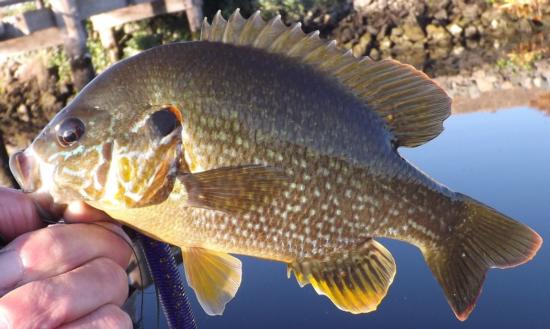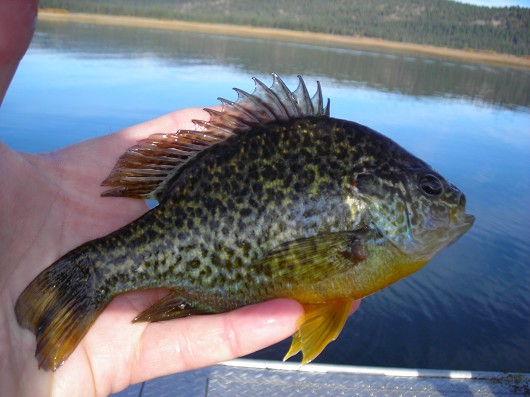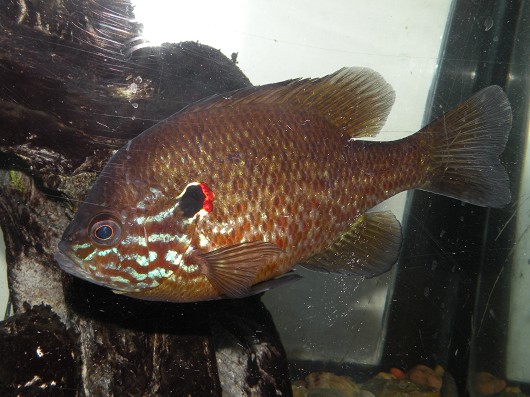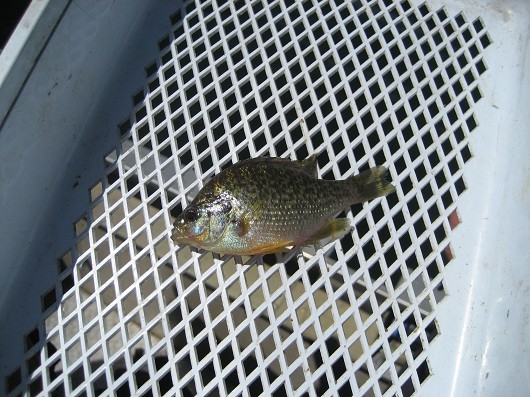Pumpkinseed
-
Scientific NameLepomis gibbosus
-
NativeNo
-
Identification
 Pumpkinseed, caught and released in the South Fork Mokelumne River, (San Joaquin County), CA, Oct. 3, 2014. Photo by Gary Riddle.
Pumpkinseed, caught and released in the South Fork Mokelumne River, (San Joaquin County), CA, Oct. 3, 2014. Photo by Gary Riddle. Pumpkinseed, captured from Lake Davis, CA. Photo by Robert Vincik, California Department of Fish and Game.
Pumpkinseed, captured from Lake Davis, CA. Photo by Robert Vincik, California Department of Fish and Game. Pumpkinseed, caught in Seneca County, New York. Photo by Arthur Masloski, December 2008.
Pumpkinseed, caught in Seneca County, New York. Photo by Arthur Masloski, December 2008. Pumpkinseed, captured at Lake Davis, CA. Photo by Dan Worth, California Department of Fish and Game.
Pumpkinseed, captured at Lake Davis, CA. Photo by Dan Worth, California Department of Fish and Game.- Deep body with small oblique mouth
- Long pectoral fins
- Short stiff opercular flaps
- 10-12 dorsal, 9-11 anal, 5 pelvic, 12-13 pectoral fin rays
- 10 dorsal, 3-4 anal, 1 pelvic spine(s)
- Small spots on the soft part of the dorsal fin
- Orange and blue streaks on the dark operculum
- 36-44 scales on the lateral line
- Gray-green to greenish brown body with orange, yellow, blue, and green spots, and 7-10 faint blue green vertical bands, yellow to orange throat and belly, and a cheek with a series of wavy blue lines
- Juveniles are a more uniform gray-green with conspicuous vertical bars
-
Life History
Pumpkinseeds are most common in clear to slightly turbid lakes, sloughs, and sluggish streams with beds of aquatic plants and large snail populations. While lab results show preference for temperatures between 24°C and 32°C, wild populations tend to be more frequent in cooler areas. In these cooler areas they can survive with dissolved oxygen levels less than 1 mg/L but warmer waters require at least 4 mg/L in order to be habitable. Pumpkinseeds can also survive in salinities up to 17 ppt. Hard-shelled invertebrates make up the majority of the Pumpkinseed diet, with snails and clams from the bottom and aquatic plants being the most common targets. This is made possible by molar-like teeth that can crush the shells, allowing hard parts to be ejected and soft parts digested. While the hard-shelled prey items are the most common food for the Pumpkinseed, bottom dwelling insect larvae like dragonflies and midges are preferred and become more important in the summer when they are abundant.
Pumpkinseeds reach maturity by their second or third year and spawn between April and June, when temperatures reach 13-17°C. Males construct nest depressions in colonies to protect their young from outside predators but each individual male will also strictly defend his nest from other males in the colony. Large males control the preferred mating sites, usually in sand or gravel, less than 1 m deep, and filled with copious woody debris. Males guard embryos until they hatch but it is believed that there are multiple mating strategies for males that may relieve some of this duty (see bluegill page for potential scenario). Females will lay 600-7,000 eggs per season in multiple males’ nests, the number increasing with female age and size. When the eggs hatch 3-5 days later the Pumpkinseed offspring make their way into open water where they will feed on plankton before settling into a bed of aquatic vegetation another several weeks later. In an area where bluegills dominate the vegetation beds, Pumpkinseed young will move into the food rich but heavily predated open water. Those that survive will have grown at a superior rate as compared to juveniles that fed only in aquatic plant beds but the size of open water populations is greatly reduced. On average however, Pumpkinseeds will grow to 25 mm in one year, and reach 132 mm in 4 years. Some Pumpkinseeds can live as long as 12 years but even at this age they rarely exceed 30 cm in length.
-
Links to Other ResearchN / A



